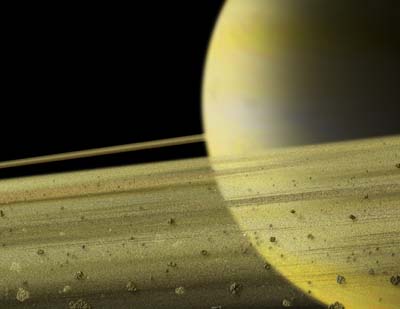Shadows of Saturn’s moons onto its rings signal approach of equinox
 Washington, March 24: Images taken by the cameras of NASA’s Cassini spacecraft have captured, for the first time, the shadows of Saturn’s moons cast onto its broad expanse of rings, which signals the approach of a phase known as equinox.
Washington, March 24: Images taken by the cameras of NASA’s Cassini spacecraft have captured, for the first time, the shadows of Saturn’s moons cast onto its broad expanse of rings, which signals the approach of a phase known as equinox.
Like Earth and most of the other planets, Saturn’s spin axis is tilted relative to its motion around the Sun.
This condition results in the cyclical passage of the Sun, seen from Saturn, from the southern hemisphere to the north and back again, and the full sweep of seasonal changes on Saturn and its rings and moons, over the course of Saturn’s year, equal to 29.5 Earth years.
Thus, about every 15 Earth years, or half-Saturn-year, the Sun passes through the plane containing the planet’s rings.
During these times, the shadows of the planet’s rings fall in the equatorial region on the planet, and the shadows of Saturn’s moons external to the rings, especially those whose orbits are inclined with respect to the equator, begin to intersect the planet’s rings.
When this occurs, the equinox period has essentially begun, and any vertical protuberances within the rings, including small embedded moons and narrow vertical warps in the rings, will also cast shadows on the rings.
At exactly the moment of equinox, the shadows of the rings on the planet will be confined to a thin line around Saturn’s equator and the rings themselves will go dark, being illuminated only on their edge.
The onset of this novel geometry begins with the appearance of the shadows of Saturn’s moons on the icy platform of its rings.
The next equinox on Saturn, when the Sun will pass from south to north, is August 11, 2009.
Because of these unique illumination circumstances, Cassini imaging scientists have been eager to observe the planet and its rings around the time of equinox, and Cassini’s first extended mission, which began on July 1, 2008, and extends to September 30, 2010, was intended to gather observations during this time.
Eventually, more moons will cast shadows on the rings and all shadows will grow longer as exact equinox approaches.
The shadows will be their longest just before and just after equinox when the Sun exactly crosses the ring plane on Aug. 11, 2009.
According to Carolyn Porco, leader of the Cassini imaging team in Boulder, Colorado, “One of the best things about being in orbit around Saturn are those mind-expanding opportunities that arise every now and again to see some celestial phenomenon you couldn’t possibly see here on Earth.” (ANI)